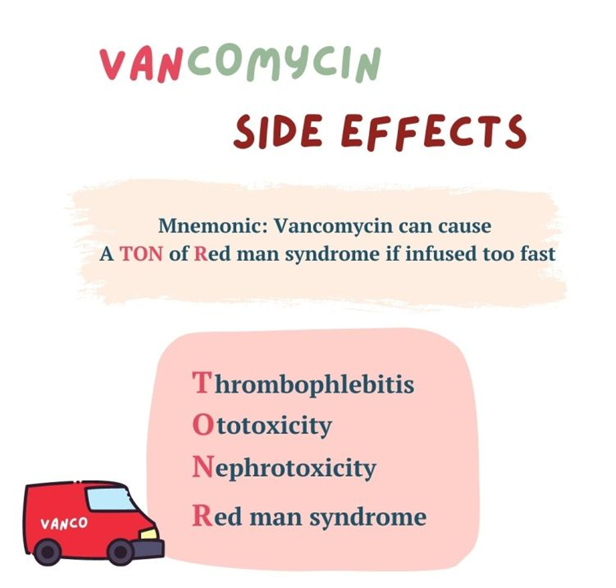Which adverse effect unique to vancomycin is caused by histamine release?
Discoloration of body fluids
Ototoxicity
Red-man syndrome
Nephrotoxicity
The Correct Answer is C
A. Discoloration of body fluids:
Vancomycin can cause discoloration of body fluids, particularly urine, resulting in a brownish discoloration. However, this is not caused by histamine release.
B. Ototoxicity:
Ototoxicity refers to damage to the inner ear structures leading to hearing loss or balance problems. While vancomycin can cause ototoxicity, it is not specifically associated with histamine release.
C. Red-man syndrome
Red-man syndrome, also known as red-neck syndrome or red-person syndrome, is a hypersensitivity reaction characterized by flushing of the skin, particularly the upper body and face, resembling a "red man." This reaction is typically associated with the rapid infusion of vancomycin and is caused by the release of histamine from mast cells and basophils. It is not an allergic reaction but rather a non-immunologic response to vancomycin.
D. Nephrotoxicity:
Nephrotoxicity refers to kidney damage caused by certain medications or toxins. While vancomycin can cause nephrotoxicity, it is not specifically associated with histamine release.

Nursing Test Bank
Naxlex Comprehensive Predictor Exams
Related Questions
Correct Answer is A
Explanation
A. Permanent, inheritable changes to DNA:
Mutations are alterations or changes in the DNA sequence of an organism's genome. These changes can be permanent and heritable, meaning they are passed on to offspring during reproduction. Mutations can occur spontaneously or be induced by various factors such as environmental agents, radiation, or errors in DNA replication or repair mechanisms. These changes can lead to variations in traits among individuals within a population and are essential for the process of evolution.
B. An organism that is capable of causing disease:
This definition refers to the term "pathogen." Pathogens are organisms, such as bacteria, viruses, fungi, or parasites, that are capable of causing disease in their hosts. Pathogens can infect humans, animals, plants, or other organisms and can lead to a wide range of diseases, from mild infections to life-threatening illnesses.
C. The severity of a disease that an organism is able to cause:
This definition refers to the term "virulence." Virulence is a measure of the severity or harmfulness of a pathogen, indicating its ability to cause disease in a host organism. Highly virulent pathogens are more likely to cause severe illness or death, while less virulent pathogens may cause milder symptoms or asymptomatic infections. Virulence factors, such as toxins, adhesion molecules, or evasion mechanisms, contribute to the pathogen's ability to cause disease.
D. A substance that can inhibit the growth of bacteria:
This definition refers to the term "antibiotic." Antibiotics are chemical substances produced by microorganisms, fungi, or synthesized in the laboratory that can inhibit the growth of or kill bacteria. Antibiotics are commonly used to treat bacterial infections and work by targeting specific bacterial structures or metabolic processes, thereby disrupting bacterial growth and survival. However, antibiotics are not mutations; instead, they are therapeutic agents used to combat bacterial infections.
Correct Answer is B
Explanation
A. 36 months:
This duration is longer than typical treatment courses for TB. While treatment for drug-resistant TB may require an extended duration, standard treatment for drug-sensitive TB typically lasts for a shorter period.
B. 6-12 months:
This duration is within the typical range for the treatment of drug-sensitive TB. Standard treatment regimens for drug-sensitive TB usually involve a combination of multiple antibiotics taken for 6 to 9 months, sometimes extending up to 12 months depending on factors such as the severity of the disease and the patient's response to treatment.
C. 2-4 weeks:
This duration is too short for the treatment of TB. TB treatment requires a prolonged course of antibiotics to ensure the complete eradication of the bacteria and to prevent the development of drug resistance.
D. 7-10 days:
This duration is too short for the treatment of TB. TB treatment typically lasts for several months rather than days, as it involves a combination of antibiotics taken for an extended period to effectively treat the infection.
Whether you are a student looking to ace your exams or a practicing nurse seeking to enhance your expertise , our nursing education contents will empower you with the confidence and competence to make a difference in the lives of patients and become a respected leader in the healthcare field.
Visit Naxlex, invest in your future and unlock endless possibilities with our unparalleled nursing education contents today
Report Wrong Answer on the Current Question
Do you disagree with the answer? If yes, what is your expected answer? Explain.
Kindly be descriptive with the issue you are facing.
